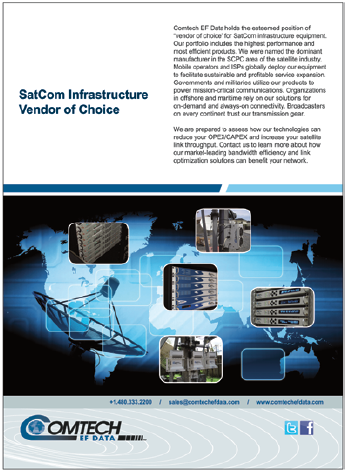According to the World Health Organization, by 2020, the majority of diseases worldwide will be caused by chronic pathologies such as diabetes, hypertension or cardiovascular conditions (see Figure 1). The treatment of such diseases requires frequent and expensive care.
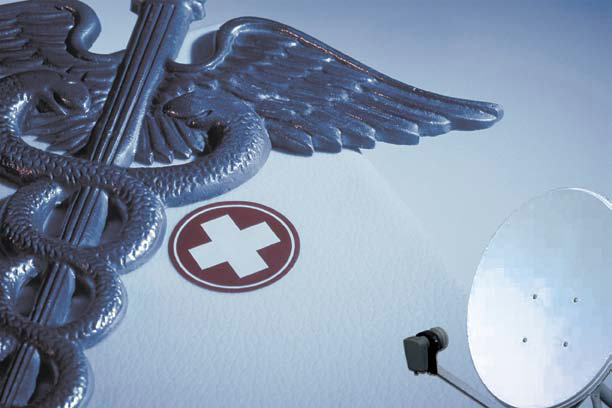
As a result, there is a clear and growing need to introduce more home care in order to offer more convenient therapy for patients as well as to reduce the cost and necessity of treatment in hospitals and health centers. In turn, this calls for an increase in support capabilities, such as remote medical monitoring and assistance.
This problem is certainly not endemic to developed societies. According to recent reports, chronic illnesses are likely to surpass maternal, child and infectious diseases as the biggest killer in sub-Saharan Africa by the year 2030. Most of these illnesses are preventable, as they arise from the consumption of sugar and fat; smoking; and sedentary lifestyles [Source: The Economist: Growing Pains, 24 September 2011]
Improvements in Information and Communications Technology (ICT) are enabling the provision of more effective and powerful remote healthcare solutions. For example, the use of high technology body sensors (i.e., to take measurements, such as pulse, blood pressure, body temperature, ECG, and so on); developments in wired and wireless communications technologies; real-time data processing; and interactive interfaces allow healthcare providers to deliver improved quality of care—especially for those patients with chronic or genetic diseases. Collectively, these initiatives are contributing to the emerging field of eHealth.
Emerging eHealth/SatHealth™ Services
Originally, eHealth was defined as the application of traditional computing to medicine. Today, however, the scope of eHealth is broadening, extending to a wide range of devices and platforms, including those used for home/hospital diagnostics and monitoring; imaging techniques; and patient-owned technologies for supporting self-management and healthcare improvement. All of these innovations are data-enabled, generating streams of vital information that should be part of all-encompassing healthcare systems.
However, eHealth services are entirely dependent on the availability of reliable, secure communications infrastructure. While in many parts of the world such infrastructure is ubiquitous, in others areas of the globe such may only be available intermittently, or is completely absent.
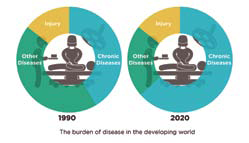
Figure 1. Growth In Chronic Diseases, 1990 to 2020. Chart courtesy of ISPM.
The provision of eHealth is limited by the reach of conventional terrestrial fixed and mobile networks. In other words, many patients who today would benefit from eHealth services, such as those in remote regions—which includes much of sub-Saharan Africa, for example—are outside regions that can be covered by such systems. There are clear gaps in the provision of remote eHealth solutions. This could lead to a digital divide between those within the reach of eHealth services and those that are not within such communication boundaries.
In this context, the use of satellite communications can fill gaps in terrestrial networks by providing access to remote areas that are beyond the reach of land or mobile communications systems. Satellite technology provides the means to extend such networks and ensure closure of the digital divide. What SatMagazine calls SatHealth™ can be a crucial enabler to support countries and agencies in the further development of health systems.
Satellite technology can improve access to, and the quality and efficiency of, healthcare systems. Universal satellite coverage is already possible via the networks already deployed. A simple infrastructure can be leveraged in order to achieve true global coverage for the provision of SatHealth services.
Telemedicine via satellite can help ensure equal access to medical expertise, irrespective of geographical location. Satellite-based broadband (fixed and mobile) access for data transmission and communication is the most suitable way to deliver a host of SatHealth services to remote areas in a fast, efficient, reliable and cost-effective manner.
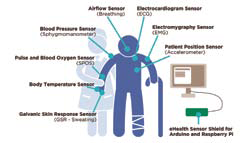
Figure 2: Remote Body Sensors
Today, the broader realm of eHealth, and the more channeled SatHealth, can be said to encompass interaction between patients and health-service providers, institution-to-institution transmission of data, or peer-to-peer communication between patients and/or health professionals. Such also includes health information networks, electronic health records, telemedicine services, and personal wearable and portable communications systems for monitoring and supporting patients. In the absence of conventional networks, satellite technology can be a key enabler for remotely delivering the benefits of eHealth on a truly global basis.
One example of current developments is that of a patient connected to a workstation, such as a home PC or any medical module that is designed for the processing of medical data (e.g., ECG or EMG), to which medical professionals have complete access (remotely or locally) in order to plan and provide healthcare.
In this case, monitoring of patients’ conditions is enabled by the continuous recording and processing of vital signs and/or activity, at pre-defined time intervals (for example, each day or hour). Data from patients’ body sensors (See Figure 2) may be transferred (in real-time or at pre-configured intervals) via wired or wireless communication to the appropriate platform (Figure 3). Here, the data can be analyzed, monitored and managed by medical professionals who can then take appropriate action.
In the absence of local fixed or mobile coverage, such data transfer can readily be facilitated by satellite transmission. The simple provision of satellite modems or other access points can be an enabler for the delivery of eHealth solutions—both simple, as in the example above, or, in the future, more complex applications—to ensure comprehensive coverage in both developed and developing regions.

Figure 3: End to End Connectivity in eHealth
Although these complex systems and data integration challenges offer significant opportunities, they also require thoughtfully designed technologies that can manage and deal with a growing number of stakeholders in an increasingly complex ecosystem.
The eHealth + SatHealth Ecosystem
The eHealth and SatHealth ecosystem is complex and includes, among others, patients; medical devices performing required measurements and providing data output; a telecommunications network that performs data transfer; platforms that collate, enrich and interpret data collected and provide diagnoses; and finally, the doctors and clinicians able to perform the correct action, or issue relevant prescriptions, in order to improve the health of the patient. In this context, the term eHealth/SatHealth comprises the following stakeholders (Figure 4):
• CSPs (fixed and/or mobile)
• Satellite network operators
• Patient and family
• Clinicians
• Healthcare providers
• Health insurance companies
• Diagnostic centers
Such an ecosystem is dependent upon the infrastructure to deliver and exchange information between different entities as well as on the ability to ensure that the data and systems perform with the required quality of service to sustain optimal performance levels. The presence of a partner with proven expertise in service management, delivery and assurance is absolutely essential to the success of the process.
Prerequisites For Successful Service Delivery
Delivery of an eHealth/SatHealth service is complex and encompasses a number of areas. Required is interoperability between different stakeholders, as well as a management system that controls and monitors the transmission of the data collected from the patient to the practitioner and the diagnostic system. The key needs, according to care providers, are standardization and interoperability to improve patient care and experience.
The most important requirements for this health-based ecosystem can be defined as follows:
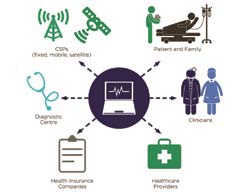
Figure 4. eHealth Stakeholder Ecosystem.
Systems Interoperability
To provide an eHealth solution, the data collected must travel from monitoring devices to multiple providers, which, in turn need to interoperate with their own platforms.
Complex Network Collection
Different data types generated by multiple devices delivered through various networks need to be collected, aggregated and monitored. This must include the means to deliver and collect information from any location, which, in turn, means that satellite operators will become significant stakeholders in the eHealth community.
Multi Provider Environment
An eHealth/SatHealth solution is comprised of multiple providers, each with its own platform that needs to seamlessly interoperate and interact to deliver the expected service.
Data Analysis
Services generate data that must be managed, aggregated and analyzed separately, or in combination with, data from other sources.
Operations
Dashboards must be presented to doctors or patients in order to allow them to take actions that result from analysis of data collected.
The ISPM Solution
ISPM, a leading vendor of flexible service assurance and management solutions for telecommunications and IT infrastructure, is an active player in the TM Forum’s Digital Health Initiative. TM Forum has established the “eHealth—Curing the Complexity” Catalyst project (http://events.tmforum.org/digital-disruption-2013/catalyst-ehealth.html).
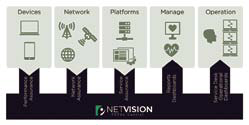
Figure 5: NetVision Solution Focus
The goal of the project is to develop a set of common practices and processes, based on the Business Process Framework (eTOM) model. These goals support each domain and activity in the eHealth/SatHealth environment. Importantly, the project involves multiple stakeholders, collaborating to create a viable ecosystem for the delivery of services. Such an ecosystem must now be extended to include satellite network operators and the suppliers of satellite connectivity equipment.
The ‘Curing the Complexity’ project demonstrates how, through the application of eTOM, partners from different industries can meet the challenges of interoperability to provide healthcare to patients. The project uses the need to deliver enhanced care to elderly patients in order to demonstrate the applicability of eTOM to healthcare scenarios. Outpatient care of the elderly can benefit from remote monitoring of medical indicators, enabling both medical professionals and family members to be updated with relevant information regarding the patient’s health.
In addition, the solution provides the means to perform remote diagnostic tests and to monitor the efficacy of prescription medicine. The team has been able to present a solution that combines hardware and software with the ability to generate real-time information from each patient. Follow-up services and advice can also be delivered, together with the capture of mobility and location data through a range of different visualization tools.
The challenge of interoperability between the partners is overcome through the use of the Standards Information (SID) and Integration (TIP) capabilities of Frameworx. Crucially, the same procedures used in the telecoms industry are reused for medical procedures with little adaptation. Similarly, the same processes can be extended to the enlarged ecosystem that includes the satellite community.
ISPM, through its NetVision solution (Figure 5), is responsible for the implementation of Service Assurance and Orchestration capabilities, managing quality levels both between each of the partners individually as well as for service as a whole. NetVision is also used to provide Medical Service Assurance capabilities for the overall solution in order to orchestrate the monitoring of remote devices; collection of indicators and medical events; the co-ordination of medical management and control of the processes of medical care. The project is a successful application of familiar concepts and processes from the telecoms industry in a new and vital market segment: Health.
The Advantages Of The Technologies
The advantage of offering eHealth/SatHealth services is becoming increasingly clear. Interesting to note is that one of the principal benefits identified is cost reduction for healthcare providers, due to fewer face-to-face appointments. As stated in the introduction, with an increasing percentage of patients suffering from chronic diseases, this is a hugely important aspect of emerging eHealth services.
However, of greater importance are benefits to patients—in particular, in the provision of services to areas that are inadequately equipped with conventional facilities and healthcare providers and which are also beyond the reach of conventional networks. There is a clear and compelling case for satellites to play a key role in delivering eHealth services and extending healthcare provision possibilities. Indeed, it could be argued that satellite technology is of fundamental importance to future eHealth provisions and development goals.
In order to successfully deliver such services, Communications Service Providers (CSPs) must be able to manage complex ecosystems, shaped by a multitude of actors: devices, networks, platforms, patients and clinicians.
The inclusion of satellite transmission for these services is expected to deliver a range of additional benefits. In particular, SatHealth will provide end-users with sustainable telemedicine services of sufficient quality to enable the delivery of improved healthcare services to populations living in remote areas.
As demonstrated in the Catalyst project, ISPM, through its NetVision solution, has been able to implement Service Assurance and Orchestration capabilities, managing quality levels between each of the partners individually as well as for the service as a whole.
ISPM is the ideal partner to connect, monitor and troubleshoot all the different devices, platforms and networks involved, including satellite transmission, and to ensure the smooth and efficient flow of data among them, while reporting the correct status of data to patients, clinicians and all stakeholders in the ecosystem.
NetVision can also be used to provide Medical Service Assurance capabilities for the overall solution in order to orchestrate the monitoring of remote devices; collection of indicators and medical events; the coordination of medical management; and control of the processes of medical care.

Please contact ISPM to discuss how a successful application of familiar concepts and processes from the telecoms industry can help evolve your network and introduce offerings for a new and critical market segment: SatHealth.
For additional details regarding ISPM, please visit their infosite at http://ispm.com/
About the author
Lorenza Brescia is based in London, England, and has responsibility for Business Development activities for ISPM’s solutions and services. Lorenza brings considerable senior-level experience to such companies as Alcatel-Lucent, Telecom Strategy Partners, and a range of TMT start-ups. Lorenza has an MBA from London Business School and a degree in OpticoElectronic Engineering from the Politecnico of Milan.


